Please refer to Chemical Bonding and Molecular Structure Class 11 Chemistry notes and questions with solutions below. These revision notes and important examination questions have been prepared based on the latest Chemistry books for Class 11. You can go through the questions and solutions below which will help you to get better marks in your examinations.
Class 11 Chemistry Chemical Bonding and Molecular Structure Notes and Questions
Some Important Points and Terms of the Chapter
1. Lewis dot structures are shorthand to represent the valence electrons of an atom. The structures are written as the element symbol surrounded by dots that represent the valence electrons.
2. Covalent Bonds – The bond formed between two atoms by mutual sharing of electrons between them so as to complete their octets or duplets. When two atoms share one electron pair they are said to be joined by a single covalent bond. e.g H2 If two atoms share two electron pairs of electrons, the covalent bond between them is called a double bond. e.g O2 If two atoms share three electron pairs of electrons, the covalent bond between them is called a double bond. e.g N2
3. Octet Rule – Kossel and Lewis in 1916 developed an important theory of chemical combination between atoms known as electronic theory of chemical bonding. According to this, atoms can combine either by transfer of valence electrons from one atom to another or by sharing of valence electrons in order to attain their octet. This is known as octet rule.
4. Limitations of octet rulea)
a. Incomplete octet of the central atom: In some compounds the number of electrons surrounding the central atom is less than eight. This is especially the case with elements having less than four valence electrons. Examples- LiCl ,BeCl2 , BCl3
b) Odd-electron molecules: In molecules with an odd number of electrons like nitric oxide, NO and nitrogen dioxide, the octet rule is not satisfied for all the atoms.
c) The expanded octet : Elements in and beyond the third period of the periodic table have, apart from 3s and 3p orbitals, 3d orbitals also available for bonding. In a number of compounds of these elements there are more than eight valence electrons around the central atom. This is termed as the expanded octet. Some of examples of such compounds are: PF5, SF6. d) This theory does not account for the shape of molecules.
5. Electrovalent bond or Ionic Bond: The chemical bond as result of transfer of electron from one tom(electropositive) to another atom (electronegative).Ionic bonds will be formed more easily between elements with comparatively low ionization enthalpies and elements with comparatively high negative value of electron gain enthalpy. Most ionic compounds have cations derived from metallic elements and anions from non-metallic elements.
6. Formation of Ionic Bond
m(g) → m+ (g) + e– ;
lonization enthalpy
X(g) + e– → X– (g) ;
Electron gain enthalpy
m+ (g) + X– (g) → MX (s)
7. Bond length is defined as the equilibrium distance between the nuclei of two bonded atoms in a molecule.
8. Bond Angle: It is defined as the angle between the orbital containing bonding electron pairs around the central atom in a molecule/complex ion. It gives some idea regarding the distribution of orbital around the central atom in a molecule/complex ion and hence it helps us in determining its shape
9. Bond enthalpy: It is defined as the amount of energy required to break one mole of bonds of a particular type between two atoms in a gaseous state. The unit of bond enthalpy is kJ mol–1
10. Bond Order : The Bond Order is given by the number of bonds between the two atoms in a molecule. E.g.: Bond Order of O2= 2. With increase in bond order, bond enthalpy increases and bond length decreases.
11. Resonance: According to the concept of resonance, whenever a single Lewis structure cannot describe a molecule accurately, a number of structures with similar energy, positions of nuclei, bonding and the non- bonding pairs of electrons are taken as the canonical structures of the hybrid which describes the molecule accurately
12. Polarity of bonds: In case of heteronuclear molecules like HCl, the shared pair of electron between the two atoms gets displaced more towards chlorine since the electronegativity of chlorine is far greater than that of hydrogen. The resultant covalent bond is called a polar covalent bond.
13. Dipole moment: As a result of polarization, the molecule possesses the dipole moment which can be defined as the product of charge and the distance between the centers of positive and negative charge. It is usually designated by a Greek letter ‘μ‘. Mathematically, it is expressed as follows: Dipole moment (μ ) = charge (Q) X distance of separation (r)
14. VSEPR Theory
• The shape of a molecule depends upon the number of valence shell electron pairs (bonded or nonbonded) around the central atom.
• Pairs of electrons in the valence shell repel one another since their electron clouds are negatively charged.
• These pairs of electrons tend to occupy such positions in space that minimize repulsion and thus maximise distance between them.
• The valence shell is taken as a sphere with the electron pairs localising on the spherical surface at maximum distance from one another.
• A multiple bond is treated as if it is a single electron pair and the two or three electron pairs of a multiple bond are treated as a single super pair.
• Where two or more resonance structures can represent a molecule, the VSEPR model is applicable to any such structure.
• The repulsive interaction of electron pairs decrease in the order: Lone pair (lp) – Lone pair (lp) > Lone pair (lp) – Bond pair (bp) > Bond pair (bp) – Bond pair (bp)
• Geometry Of Molecules On The Basis Of VSEPR Theory

15. Hybridization: It can be defined as the process of intermixing of the orbitals of slightly different energies so as to redistribute their energies, resulting in the formations of new set of orbitals of equivalent energies and shape.
• Salient Features of hybridization :
• The number of hybrid orbitals is equal to the number of the atomic orbitals that get hybridised.
• The hybridised orbitals are always equivalent in energy and shape.
• The hybrid orbitals are more effective in forming stable bonds than the pure atomic orbitals.
• These hybrid orbitals are directed in space in some preferred direction to have minimum repulsion between electron pairs and thus a stable arrangement.
16. Types of Hybridisation
• sp hybridisation- This type of hybridisation involves the mixing of one s and one p orbital resulting in the formation of two equivalent sp hybrid orbitals.e.g.BeCl2
• sp2 hybridisation- In this hybridisation there is involvement of one s and two p-orbitals in order to form there equivalent sp2 hybridised orbitals. e.g.BCl3
• sp3 hybridisation- When there is mixing of one s and three p-orbitals of the valence shell to form four sp3 hybrid orbitals of equivalent energies and shape. e.g.CH4
17. Molecular orbital. It gives electron probability distribution around a group of nuclei in a molecule. They are filled in the same way as atomic orbitals. Molecular orbitals are formed by linear combination of atomic orbitals.
18. Bonding molecular orbital. A molecular orbital that is formed by addition overlap (i.e., when the lobes of atomic orbitals overlap with the same sign) of two atomic orbitals is known as bonding molecular orbital. It is represented as ψMO = ψA + ψB Its energy is lower than the atomic orbitals from which it is formed. It favours bonding.
19. Anti-bonding molecular orbital. A molecular orbital that is obtained by the subtraction overlap (i.e., when the lobes of atomic orbitals overlap with the opposite sign) of two atomic orbitals is know as anti-bonding molecular orbital. It is represented as ψ*MO = A – ψB Its energy is higher than the atomic orbitals from which it is formed. It does not favour bonding.
20. Bond order. It is defined as half of the difference between number of electrons in bonding and anti-bonding orbitals, i.e., B.O. = ½ (Nb – Na) ‘where Nb are number of electrons in bonding orbitals‘ and Na are number of electrons in anti-bonding orbitals. Bond order helps in estimating stability of atom.
21. Relationship between electronic configuration and molecular behaviour :
(a) If Nb is greater than Na, the molecule is stable.
(b) The molecule is unstable if Na is greater than Nb.
(c) The molecule is also unstable if Na is equal to Nb because anti-bonding effect is stronger than bonding effect.
22. Sigma (σ) molecular orbitals. A molecular orbital which is formed from the overlap of two s atomic orbitlas or head to head overlap of one s and p-atomic orbitals or head to head overlap of two p-atomic orbitals, is known as sigma molecular orbital.
23. pi (π) molecular orbitals. A molecular orbital which is formed by lateral overlap of two parallel p-orbitals is known as pi(π) molecular orbital.
24. Conditions for the Combination of Atomic Orbitals. The linear combination of atomic orbitals takes place only if the following conditions are satisfied :
(i) The combining atomic orbitals must have same or nearly same energy.
(ii) The combining atomic orbitals must have the same symmetry about the molecular axis. By convention, z-axis is taken as the molecular axis.
(iii) The combining atomic orbitals must overlap to the maximum extent. Greater the extent of overlapping, the greater will be electron density between the nuclei of a molecular orbital.
25. Energy level Diagrams for Molecular Orbitals. The increasing order of energies of various molecular orbitals for O2 and F2 is given below.
* * * * *
σ1s < σ1s < σ2s <σ2s <σ2pz <π2px = π2py <π2px = π2py <σ2pz
However, this sequence of energy levels of molecular orbitals is not correct for remaining molecules Li2, Be2, B2, C2, N2. For instance, it has been observed experimentally that for molecules such as B2, C2, N2 etc., the increasing order of energies of various molecular orbitals is
* * * * *
σ1s < σ1s < σ2s <σ2s <π2px = < π2py < σ2pz < π2px = π2py <σ2pz
The important characteristic feature of this order is that the energy of σ2pz molecular orbital is higher than that of π2px and π2py molecular orbitals in these molecules
Important Questions Chemical Bonding and Molecular Structure
Question: How do you express the bond strength in terms of bond order?
Ans: Bond strength represents the extent of bonding between two atoms forming a molecule. The larger the bond energy, the stronger is the bond and the greater is the bond order.
Question: Define the bond length.
Ans: Bond length is defined as the equilibrium distance between the nuclei of two bonded atoms in a molecule.
Question: Write the significance of a plus and a minus sign shown in representing the orbitals.
Ans: Molecular orbitals are represented by wave functions. A plus sign in an orbital indicates a positive wave function while a minus sign in an orbital represents a negative wave function.
Question: Define lattice enthalpy.
Ans: The energy required when one mole of an ionic compound in crystalline form is split into the constituent ions is called lattice enthalpy.
Question: Arrange the bonds in order of increasing ionic character in the molecules:
LiF, K2O, N2, SO2 and ClF3.
Ans: N2< SO2 < ClF3< K2O< LiF.
Question: The skeletal structure of CH3COOH as shown below is correct, but some of the bonds are shown incorrectly. Write the correct Lewis structure for acetic acid.

Ans: The correct Lewis structure for acetic acid is as follows:

Question: Define octet rule.
Ans: The elements tend to adjust the arrangement of their electrons in such a way that they (except H and He) achieve eight electrons in their outermost shell. This is called octet rule.
Question: What is the total number of sigma and pi bonds in the following molecules?
(a) C2H2 (b) C2H4
Ans: there are three sigma and two pi-bonds in C2H2 .
there are five sigma bonds and one pi-bond in C2H4.
Question: Which type of bond is formed when the atoms have zero difference in electronegativity?
Ans: Covalent bond.
Question: H3PO3 can be represented by structures 1 and 2 shown below. Can these two structures be taken as the canonical forms of the resonance hybrid representing H3PO3 ? If not, give reasons for the same.

Ans: The given structures cannot be taken as the canonical forms of the resonance hybrid of H3PO3 because the positions of the atoms have changed.
Question: Use molecular orbital theory to explain why the Be2 molecule does not exist.
Ans: The electronic configuration of Beryllium is .1s2, 2s2
The molecular orbital electronic configuration for Be2 molecule can be written as:

Where,
Nb = Number of electrons in bonding orbitals
Na = Number of electrons in anti-bonding orbitals
: Bond order of Be2 =1 / 2(4-4)= 0
A negative or zero bond order means that the molecule is unstable. Hence, Be2 molecule does not exist.
Question: Define hydrogen bond. Is it weaker or stronger than the van der Waals forces?
Ans: A hydrogen bond is defined as an attractive force acting between the hydrogen attached to an electronegative atom of one molecule and an electronegative atom of a different molecule (may be of the same kind). There are two types of H-bonds:
(i) Intermolecular H-bond e.g., HF, H2O etc.
(ii) Intramolecular H-bond e.g., o-nitrophenol

Hydrogen bonds are stronger than Van der Walls forces since hydrogen bonds are regarded as an extreme form of dipole-dipole interaction.
Question: Explain the important aspects of resonance with reference to the CO32- ion.
Ans: According to experimental findings, all carbon to oxygen bonds in CO32- are equivalent. Hence, it is inadequate to represent CO32- ion by a single Lewis structure having two single bonds and one double bond. Therefore, carbonate ion is described as a resonance hybrid of the following
structures:

Question: Distinguish between a sigma and a pi bond.
Ans: The following are the differences between sigma and pi-bonds:

Question: Use Lewis symbols to show electron transfer between the following atoms to form cations and anions:
(a) Ca and O (c) Al and N.
Ans(a) Ca and O:
The electronic configurations of Ca and O are as follows:
Ca: 2, 8, 8, 2 O: 2, 6
Oxygen requires two electrons more to complete its octet, whereas calcium has two electrons more than the nearest noble gas i.e., Argon. Hence, the electron transfer takes place as:

(b) Al and N:
The electronic configurations of Al and N are as follows:
Al: 2, 8, 3 N: 2, 5
Nitrogen is three electrons short of the nearest noble gas (Neon), whereas aluminium has three electrons more than Neon. Hence, the electron transference can be shown as:

Question: Write the favourable factors for the formation of ionic bond.
Ans: (i) Low ionization enthalpy of metal atom.
(ii) High electron gain enthalpy (ΔegH) of a non-metal atom.
(iii) High lattice energy of the compound formed.
Question: Although both CO2 and H2O are triatomic molecules, the shape of H2O molecule is bent while that of CO2 is linear. Explain this on the basis of dipole moment.
Ans: According to experimental results, the dipole moment of carbon dioxide is zero. This is possible only if the molecule is linear so that the dipole moments of C– O bonds are equal and opposite to nullify each other.

Resultant μ = 0 D
H2O , on the other hand, has a dipole moment value of 1.84 D (though it is a triatomic molecule as CO2 ). The value of the dipole moment suggests that the structure of H2O molecule is bent where the dipole moment of O–H bonds are unequal.

Question: Write the favourable factors for the formation of ionic bond.
Ans: (i) Low ionization enthalpy of metal atom.
(ii) High electron gain enthalpy (ΔegH) of a non-metal atom.
(iii) High lattice energy of the compound formed.
Question: Although geometries of NH3 and H2O molecules are distorted tetrahedral, bond angle in water is less than that of ammonia. Discuss.
Ans: The molecular geometry of NH3 and H2O can be shown as:

The central atom (N) in NH3 has one lone pair and there are three bond pairs. In H2O , there are two lone pairs and two bond pairs.
The two lone pairs present in the oxygen atom of H2O molecule repels the two bond pairs. This repulsion is stronger than the repulsion between the lone pair and the
three bond pairs on the nitrogen atom. Since the repulsions on the bond pairs in H2O molecule are greater than that in NH3 , the bond angle in water is less than that of ammonia.
Question: Write the significance/applications of dipole moment.
Ans: Dipole moment is the measure of the polarity of a bond. It is used to differentiate between polar and non-polar bonds since all non-polar molecules (e.g. H2, O2) have zero dipole moments. It is also helpful in calculating the percentage ionic character of a molecule.

Question: Explain with the help of suitable example polar covalent bond.
Ans: When two dissimilar atoms having different electronegativities combine to form a covalent bond, the bond pair of electrons is not shared equally. The bond pair shifts towards the nucleus of the atom having greater electronegativity.
As a result, electron distribution gets distorted and the electron cloud is displaced towards the electronegative atom. As a result, the electronegative atom becomes slightly negatively charged while the other atom becomes slightly positively charged. Thus, opposite poles are developed in the molecule and this type of a bond is called a polar covalent bond.
HCl, for example, contains a polar covalent bond. Chlorine atom is more electronegative than hydrogen atom. Hence, the bond pair lies towards chlorine and therefore, it acquires a partial negative charge.
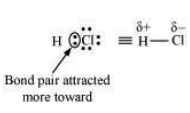
Question: Describe the hybridisation in case of PCl5. Why are the axial bonds longer as compared to equatorial bonds?
Ans: The ground state and excited state outer electronic configurations of phosphorus (Z = 15) are:
Ground state:

Phosphorus atom is sp3d hybridized in the excited state. These orbitals are filled by the electron pairs donated by five Cl atoms as:

The five sp3d hybrid orbitals are directed towards the five corners of the trigonal bipyramidals. Hence, the geometry of PCl5 can be represented as:

There are five P–Cl sigma bonds in PCl5 . Three P–Cl bonds lie in one plane and make an angle of 120° with each other. These bonds are called equatorial bonds. The remaining two P–Cl bonds lie above and below the equatorial plane and make an angle of 90° with the plane. These bonds are called axial bonds.
As the axial bond pairs suffer more repulsion from the equatorial bond pairs, axial bonds are slightly longer than equatorial bonds.
Question: Write the important conditions required for the linear combination of atomic orbitals to form molecular orbitals.
Ans: The given conditions should be satisfied by atomic orbitals to form molecular orbitals:
(a) The combining atomic orbitals must have the same or nearly the same energy. This means that in a homonuclear molecule, the 1s-atomic orbital of an atom can combine with the 1s-atomic orbital of another atom, and not with the 2s-orbital.
(b) The combining atomic orbitals must have proper orientations to ensure that the overlap is maximum.
(c) The extent of overlapping should be large.
Question: What is meant by the term bond order? Calculate the bond order of: N2, O2, and . O2– and . O2–
Ans: Bond order is defined as one half of the difference between the number of electrons present in the bonding and anti-bonding orbitals of a molecule.
Bond order = 1 / 2(Nb -Na )
Bond order of N2

Number of bonding electrons, Nb = 10
Number of anti-bonding electrons, Na = 4
Bond order of nitrogen molecule = 1/2 (10 – 4 )= 3
Bond order of O2

Hence, the bond order of oxygen molecule is 2.
Similarly, the electronic configuration of O2+ can be written as:

The electronic configuration of O2– ion will be:

Question: Write Lewis dot symbols for atoms of the following elements: Mg, Na, B, O, N, Br.
Ans:

Question: Draw diagrams showing the formation of a double bond and a triple bond between carbon atoms in C2H4 and C2H2 molecules.
Ans: C2H4 :The electronic configuration of C-atom in the excited state is:

In the formation of an ethane molecule (C2H4 ), one sp2 hybrid orbital of carbon overlaps a sp2hybridized orbital of another carbon atom, thereby forming a C-C sigma bond. The remaining two sp2 orbitals of each carbon atom form a sp2-s sigma bond with two hydrogen atoms. The unhybridized orbital of one carbon atom undergoes sidewise overlap with the orbital of a similar kind present on another carbon atom to form a weak π-bond.
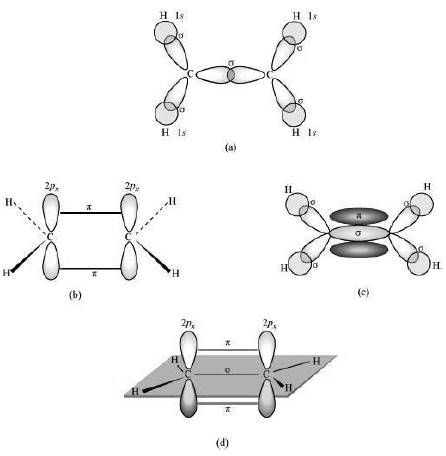
C2H2 :
In the formation of C2H2 molecule, each C–atom is sp hybridized with two 2porbitals in an unhybridized state.
One sp orbital of each carbon atom overlaps with the other along the internuclear axis forming a C–C sigma bond. The second sp orbital of each C–atom overlaps a half-filled 1s-orbital to form a σ bond.
The two unhybridized 2p-orbitals of the first carbon undergo sidewise overlap with the 2p orbital of another carbon atom, thereby forming two pi (π) bonds between carbon atoms. Hence, the triple bond between two carbon atoms is made up of one sigma and two π-bonds.

Question: Explain the formation of H2 molecule on the basis of valence bond theory.
Ans: Let us assume that two hydrogen atoms (A and B) with nuclei (NA and NB) and electrons (eA and eB) are taken to undergo a reaction to form a hydrogen molecule. When A and B are at a large distance, there is no interaction between them. As they begin to approach each other, the attractive and repulsive forces start operating.
Attractive force arises between:
(a) Nucleus of one atom and its own electron i.e., NA – eA and NB– eB.
(b) Nucleus of one atom and electron of another atom i.e., NA – eB and NB– eA .
Repulsive force arises between:
(a) Electrons of two atoms i.e., eA – eB.
(b) Nuclei of two atoms i.e., NA – NB.
The force of attraction brings the two atoms together, whereas the force of repulsion tends to push them apart.

The magnitude of the attractive forces is more than that of the repulsive forces. Hence, the two atoms approach each other. As a result, the potential energy decreases. Finally, a state is reached when the attractive forces balance the repulsive forces and the system acquires minimum energy. This leads to the formation of a dihydrogen molecule.
Question: Discuss the shape of the following molecules using the VSEPR model:
BeCl2, BCl3, SiCl4, AsF5, H2S, PH3
Ans: BeCl2: The central atom has no lone pair and there are two bond pairs. i.e., BeCl2 is of the type AB2. Hence, it has a linear shape.

Question: Write the resonance structures for SO3, NO2 and . NO2–
Ans: The resonance structures are:

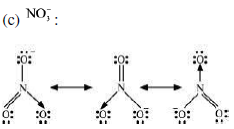
Question: What do you understand by bond pairs and lone pairs of electrons? Illustrate by giving example.
Ans: The shared pairs of electrons present between the bonded atoms are called bond pairs. All valence electrons may not participate in bonding. The electron pairs that do not participate in bonding are called lone pairs of electrons.
In H2O, there are two bond pairs and two lone pairs on the central atom (oxygen).

Question: Define octet rule. Write its significance and limitations.
Ans: The octet rule or the electronic theory of chemical bonding was developed by Kossel and Lewis. According to this rule, atoms can combine either by transfer of valence electrons from one atom to another or by sharing their valence electrons in order to attain the nearest noble gas configuration by having an octet in their valence shell.

The octet rule successfully explained the formation of chemical bonds depending upon the nature of the element.
Limitations of the octet theory:
The following are the limitations of the octet rule:
(a) The rule failed to predict the shape and relative stability of molecules.
(b) It is based upon the inert nature of noble gases. However, some noble gases like xenon and krypton form compounds such as XeF2, KrF2 etc.
(c) The octet rule cannot be applied to the elements in and beyond the third period of the periodic table. The elements present in these periods have more than eight valence electrons around the central atom. For example: PF5, SF6, etc

d) The octet rule is not satisfied for all atoms in a molecule having an odd number of electrons. For example, NO and NO2 do not satisfy the octet rule.

(e) This rule cannot be applied to those compounds in which the number of electrons surrounding the central atom is less than eight. For example, LiCl, BeH2, AlCl3 etc. do not obey the octet rule

Question: Which hybrid orbitals are used by carbon atoms in the following molecules?
CH3–CH3; (b) CH3–CH=CH2; (c) CH3-CH2-OH; (d) CH3-CHO (e) CH3COOH
Ans: (a)
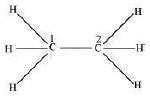
Both C1 and C2 are sp3 hybridized.
(b)
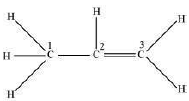
C1 is sp3 hybridized, while C2 and C3 are sp2 hybridized.
(c)

Both C1 and C2 are sp3 hybridized.
(d)
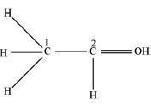
C1 is sp3 hybridized and C2 is sp2 hybridized.
(e)

C1 is sp3 hybridized and C2 is sp2 hybridized.
Question: Compare the relative stability of the following species and indicate their magnetic properties;
O2, O2+,O2 –(superoxide), O22- (peroxide)
Ans: There are 16 electrons in a molecule of dioxygen, 8 from each oxygen atom. The electronic configuration of oxygen molecule can be written as:

Since the 1s orbital of each oxygen atom is not involved in boding, the number of bonding electrons = 8 = Nb and the number of anti-bonding orbitals = 4 = Na.
Bond order= 1 / 2( Nb-Na)
= 1/ 2 (8-4)
= 2
Similarly, the electronic configuration of can O2+ be written as:

Nb= 8
Na = 3
Bond order of O2+ = = 1/ 2 (8-3)
Electronic configuration of O2– ion will be:

Nb= 8
Na = 5
Bond order of O22- = = 1/ 2 (8-5)
= 1.5
Electronic configuration of O22- ion will be:

Nb= 8
Na = 6
Bond order of O22- = = 1/ 2 (8-6)
= 1
Bond dissociation energy is directly proportional to bond order. Thus, the higher the bond order, the greater will be the stability. On this basis, the order of stability is O2+ >O2 >O2 > O22-



